The San Dimas Hotel
Originally built as a hotel, it became the Walker House.
The San Dimas Historical Society is located on the second floor.
The RailRoad
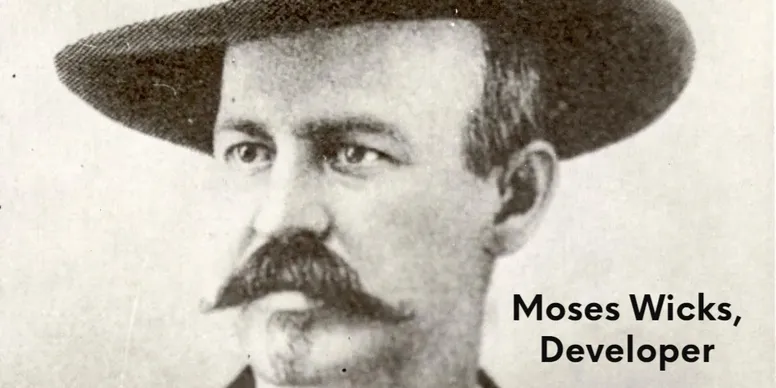
The completion of the Santa Fe Railroad line in 1887 from Los Angeles to San Bernardino marked the birth of San Dimas as a major citrus farming community. The San Jose Ranch Company, formed by Moses Wicks and four partners, laid out town sites after the company acquired most of the land that would later become San Dimas. Mr. Wicks created a promotional program to induce people to buy town lots and agricultural acreage for fruit production. This gave rise to the need for temporary housing where interested buyers would be able to stay while company officials showed them the area.
Construction
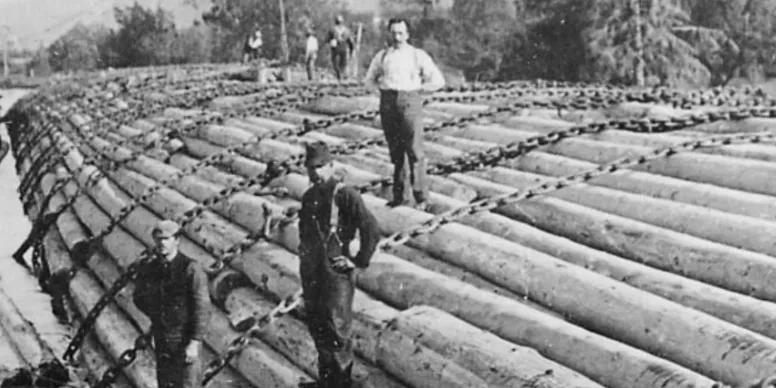
Pine logs from Oregon and redwood from Northern California were floated down the coast in large log rafts to the port of San Pedro. From there, the logs were hauled by horse and wagon to a site east of San Dimas Avenue, south of the railroad tracks. A sawmill was built and the lumber for the San Dimas hotel, the original Santa Fe railroad depot, and numerous other buildings was milled.
Architecture
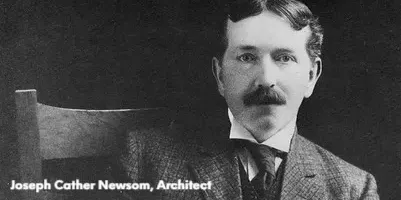
The construction of the hotel building began in 1885 and was completed in 1887. The building was designed by the prominent San Francisco architects of Joseph and Samuel Newsom noted for designing many of California’s finest buildings of that era. The structure is considered an excellent example of the Eastlake variation of the Queen Anne style, Queen Anne Revival.
Landscaped by Mr. Meserve, a pioneer nurseryman of Pomona, the hotel’s massive Deodar cedar and Hoop pine trees are among the tallest and oldest species in California and date back to the time of construction.
Just The Facts
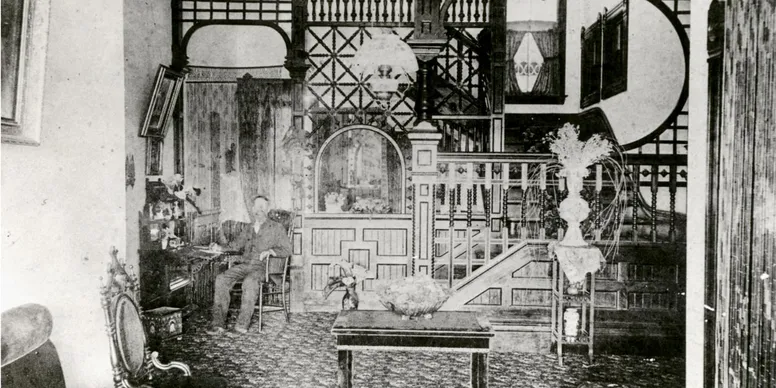
The siding and all woodwork inside of the house are redwood. The 13,200 square foot hotel contained 30 rooms with ceiling heights of 12 feet. Originally lit by kerosene lamps, electricity was introduced in 1902. The building was heated by 14 fireplaces, sharing 7 chimneys. In later years a coal furnace was installed that consumed a ton of coal per week during chilly Southern California winters.
Recession of 1880’s
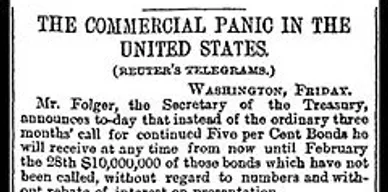
Unfortunately, by the time the hotel was completed, the land boom had collapsed. Only twelve lots were initially sold in downtown San Dimas. Accordingly, the San Dimas Hotel was never used as a hotel. The only occupants were Mr. Wicks and his partners. It never had a paying guest.
New Owners

In the fall of 1889, James and Sue Walker of Covington, Kentucky, purchased the hotel and a 40-acre ranch west of the town for $25,000. The Walkers moved in, and soon this gracious and hospitable couple became known as Aunt Sue and Uncle Jimmy. Their home became the center of most of the little town’s activities. The town’s first private school held classes in the basement, the first church services in the living room, and the early clubs met there in the only building big enough to hold the people. From 1889 to 1978, Walker family descendants lived in this Victorian home once destined to be a hotel.
Marketing California’s Gold by Ralph Thomas
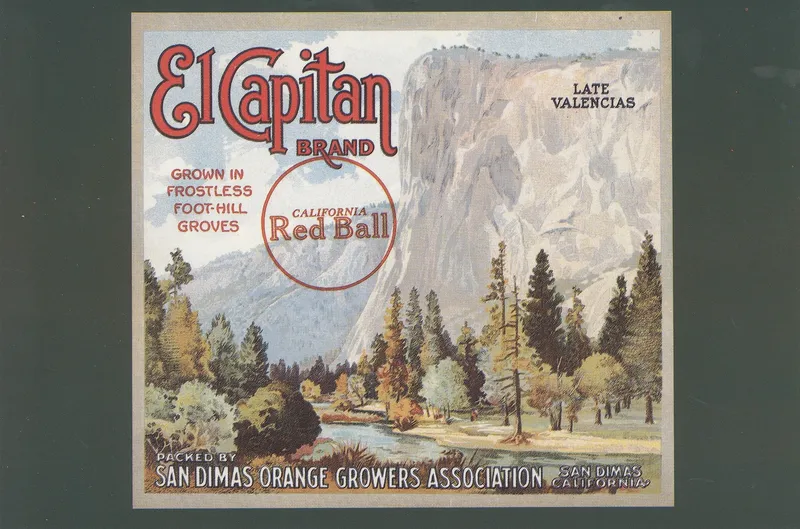
Marketing California’s Gold
Ralph H. Thomas
Today, we take marketing for granted. It is everywhere. Products are advertised on TV, radio, billboards, the internet, iPhones, and social media. It is hard to imagine that marketing, advertising, and product branding were relatively new concepts in 1900. Early marketers determined that demand consisted of more than simply purchasing power. It was driven by consumer desire. New experiences with advertising were proving that desire could be increased and molded by factors other than the mere existence of supply. As the number of products steadily increased at the beginning of the 20th century, marketers realized that the market was shifting from a seller’s market to a buyer’s market. As citrus production increased beyond what could be consumed locally, this shift also applied to the California citrus industry. California citrus growers and shippers would be faced with how to market and sell California’s gold beyond local markets.
Prior to the 1840s, land west of the Mississippi was considered a wasteland of little value. This would all change in 1849 when gold was discovered in California. Over the next 25 years, milestones such as the passing of the Homestead Act of 1862, completion of the transcontinental railroad and the telegraph in 1869, and introduction of the Washington Navel orange to California in 1873, would bring the second “Gold Rush”.
Promotions for Southern California by the Southern Pacific Railroad promised year-round sunshine and glorified farming in order to entice people to relocate there. “It was not until the opening of the Atchison, Topeka, and Santa Fe (rail) lines in 1885 that the highest development took place,” Rahno Mabel MacCurdy wrote in The History of the California Fruit Growers Exchange. “From this time on there was a veritable boom in orange planting,” MacCurdy noted. Between 1880 and 1893, California’s citrus acreage jumped from 3,000 to over 40,000. These events would soon present early citrus growers with a class of problems they had never faced before; how to pack, ship, and market their oranges to consumers who lived thousands of miles away.
Until the mid-1880s, oranges were grown in California mainly for local consumption. By the late 1880s, California citrus production exceeded what local markets could handle. California citrus growers soon realized that in order to survive, they would need to ship their oranges east. Growers were faced with a number of challenges shipping their fruit outside California. There were weak distribution methods, no marketing capabilities, and 2,000-3,000 miles that separated them from Eastern markets.
As early as the 1880s, growers were branding their citrus by stenciling their names on the end of their wooded citrus crates. By 1885, these stencils were replaced with paper labels that were glued on the ends of wooden citrus crates. This was the first form of advertising that was used locally and would continue to be an element of advertising for the next 70 years.
The first step in creating a national marketing strategy was to coordinate growers’ and packers’ interests by creating an organization that would improve current methods of selling citrus. A number of marketing organizations were created between 1885 and 1891, but because of a lack of collaboration and in-fighting, they all failed. Finally, in 1892, the first 2 successful citrus growers’ associations (organized by and for growers) were formed. They would become the foundation of the Southern California Fruit Exchange, which was formed in 1893. This organization created a “pool” from which to process and market its member’s fruit. The packing houses belonging to the cooperative graded, packed and shipped the fruit, which the Exchange marketed. Each grower received a share of the proceeds based on quality, as well as the quantity of the fruit that was marketed. Through branding and advertising, the orange would be transformed from a luxury household item to a necessity.
Prior to 1893, the quality of citrus had been unregulated. One cornerstone of the new Exchange was quality. As a member of the exchange, growers and packers were required to supply and sell only the highest quality citrus. Growers and packers were desperate for an effective way to sell their citrus and thus they joined the Exchange. In its first season of operation, the exchange represented 80 percent of all the orange growers in Southern California. Over the next 10 years, the Exchange would experience a decrease in market share due to increased competition from old established dealers, commission agents, and independent shippers. By 1903, the Exchange represented only 47 percent of the orange output of Southern California. In 1904, the Exchange announced to its members that it had decided to expand beyond its focus on quality and the orderly distribution of fruit to expand its sales force and marketing efforts. This would be the beginning of one of the most successful marketing organizations of all time. To more effectively represent not only Southern California growers, but growers throughout the state, in 1905 the name of the cooperative was changed to the California Fruit Growers Exchange (Sunkist). By the end of the 1904-05 growing season, the Exchange would represent 45 percent of California’s entire citrus industry.
The Exchange was now ready to launch its first advertising campaign. Although there were many Exchange members against advertising because they felt it was an unnecessary extravagance, in 1907, $10,000 was approved to launch the first advertising campaign. A three-color newspaper ad in black, green, and orange was developed to promote oranges. It would mark the first time a perishable fruit product was ever advertised. On March 2, 1908, the ad ran in the Des Moines Register declaring “Orange Week in Iowa”. The campaign cost less than $7,000. While business for the country as a whole increased 20 percent, business in Iowa alone gained 50%.
The Exchange realized that it needed a trademark/logo rather than just using the Exchange name. In April 1908, the Exchange agreed on the word “Sunkist” as its trademark to appear on its best grades of fruit.
“The purpose of advertising is to bring people to the product and the purpose of merchandising is to bring the product to people. The Exchange was now ready to launch its first merchandising campaign. To ensure that the Sunkist trademark would be exclusively associated with the Exchange, a plan also was developed to stamp the paper wrapper that enveloped each piece of fruit with the “Sunkist” name. And to make sure that those wrappers stayed on the fruit until the consumer bought it, the Exchange offered a promotional gift. For every twelve wrappers and twelve cents a consumer turned in, he or she would receive a sharp-pointed spoon for eating oranges cut in half. Thousands of orders poured in, causing the Exchange to add knives and forks to the offer.”
“Many a bride in the period 1910 to 1917 started her silver service with the Orange Blossom silverware offered by the Exchange,” The Sunkist Courier recalled many years later. “So popular was the offer that the orders for spoons reached the staggering total of over 5,000 per day. The Exchange became the largest single purchaser of flat silver in the world.”
By 1915, the Exchange’s advertising budget had increased to $250,000 a year. Color ads were placed in famous national magazines. These ads also included coupons for cookbooks, recipes, and suggestions for use of citrus. The exchange membership was now producing 12 million boxes of oranges a year and consisted of 8,000 members (or 65%) of California’s citrus growers. The Exchange knew in order to keep and grow its membership it would need to seek other ways to market the growing citrus crop.
Until 1916, orange juice was virtually unknown. Oranges were eaten on the half-shell or sliced and eaten. In 1916, one of the most successful advertising campaigns the Exchange ran began to appear in national magazines. “The “Drink an Orange” campaign marked the first time orange juice was promoted. “Because there were no juice extractors large enough for oranges on the market, the Exchange assisted in the development and distribution of the devices. It persuaded glass companies to produce a million glass reamers for the exchange to distribute through retail outlets. Glass hand juicers were offered for 10 cents each.” The “Drink an Orange” campaign had exceeded all expectations. Consumption of oranges increased from half an orange per serving to three per serving.
“Juice advertising became one of the most powerful innovations the Exchange ever introduced. In addition to non-exchange members, others benefited as well. Producers of tomatoes, grapes, apples, and prunes soon followed what the Exchange had done.”
By 1920, Exchange members were producing almost 75% of all the citrus in California. The discovery in 1912 that a lack of vitamins could lead to disease would produce another opportunity to market its members citrus. In 1920, the Exchange would become the first to mention vitamins in its ad copy, emphasizing Vitamin C. It had been reported that Vitamin C could be found in large amounts in citrus fruit. Through the 1920s, orange juice consumption would be promoted focusing on its nutritional value to young children. The Exchange would also manufacture and sell thousands of Sunkist Electric Fruit Juice Extractors to soda fountains introducing fresh squeezed orange juice on a large scale. The Exchange would focus its advertising on the healthful benefits of Vitamin C and citrus for the next two decades.
In the late 1920s, the Exchange would use other marketing approaches. It would sponsor the first commercial radio broadcast between California and the East Coast. It would also be the first organization to use motion picture stars in radio programs. These programs were interspersed with announcements about the healthfulness of Sunkist oranges and orange juice. In 1926, oranges would be stamped with the Sunkist brand, eliminating the need for tissue wrappers that once carried the brand name.
By 1930, the Exchange continued to diversify its advertising campaigns, promoting the Sunkist name and its high-quality citrus. One popular means of advertising was using promotional signs on thousands of streetcars across the country. Another method of exposure was sponsoring weekly radio programs. The name “Sunkist” had become the world’s best know brand for fresh fruit. “Surveys indicated that advertising by the Exchange had played a big role in increasing per-capita consumption of oranges from 31 a year in 1906, to 52 by 1926, and to 79 by 1936.”
During the 1940s, the Exchange used network radio to advertise the Sunkist brand. Radio provided coverage not only to the large metropolitan areas but the surrounding rural and small towns as well. The Exchange expanded its use of newspapers and national magazines. “In one of the most popular pieces in its history, the Exchange promoted the “Sunkist Baby” in its Valencia orange advertisements. The healthy little girl showed, in consecutive ads, how nicely “Sunkist-fed” babies grew from year to year.” During World War II, citrus production reached an all-time high.
As with anything else, that which goes up must eventually come down and the citrus industry inevitably began to decline by the 1950s as a result of urban development across Southern California. “The rapid and persistent growth of Southern California during the war and since is changing somewhat the map of citrus production,” the Exchange general manager wrote. “Citrus groves in the Los Angeles Metropolitan area and around the perimeter of the principal citrus belt communities are giving way to sub-division and other types of construction caused by industrial development in the area.” With these changes, the heyday of marketing California’s gold came to an end.
Sources: Heritage of Gold-The First 100 Years of Sunkist Growers
The California Citrograph